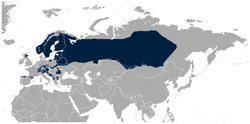| Tetrao Temporal range: Early Pliocene to recent | |
|---|---|
 | |
| Western capercaillie (Tetrao urogallus) | |
| Scientific classification | |
| Domain: | Eukaryota |
| Kingdom: | Animalia |
| Phylum: | Chordata |
| Class: | Aves |
| Order: | Galliformes |
| Family: | Phasianidae |
| Tribe: | Tetraonini |
| Genus: | Tetrao Linnaeus, 1758 |
| Type species | |
| Tetrao urogallus Linnaeus, 1758 | |
| Species | |
Tetrao is a genus of birds in the grouse subfamily known as capercaillies. They are some of the largest living grouse and can be found in the forested areas of the Eurasian Palearctic.
Contents
Feathers from the bird were used to decorate the characteristic hat of the bersaglieri, an Italian ace infantry formation.







